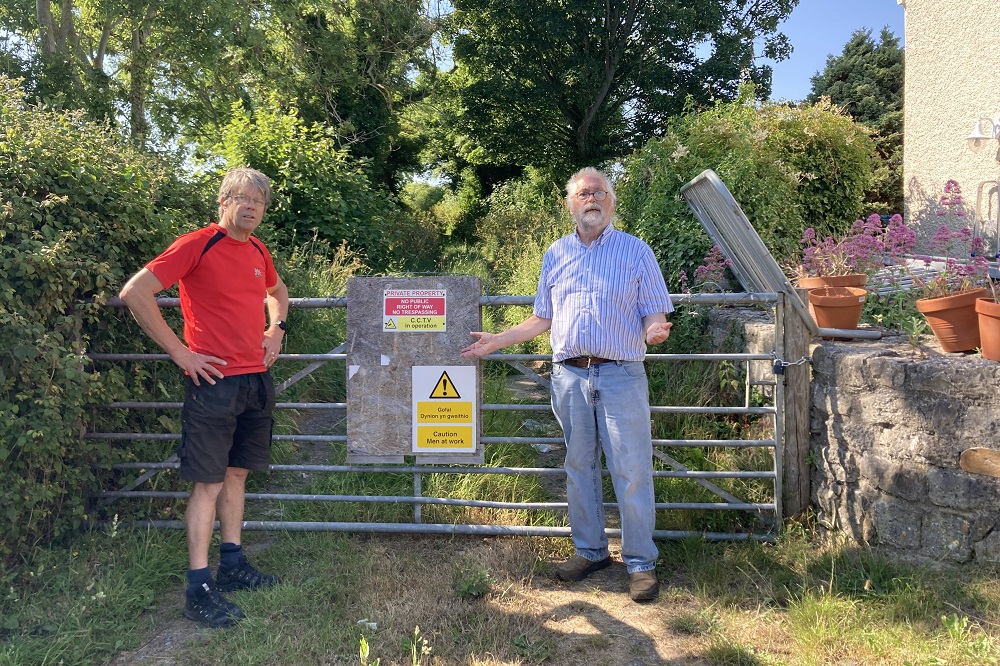Decision looms over footpath row at Anglesey beauty spot

Dale Spridgeon, local democracy reporter
Villagers are hoping a two-year legal wrangle over the right to access a footpath blocked off close to a luxury holiday home development might soon be over.
A group in Llangoed has been campaigning to save a rural route used by locals “for generations” and say an Isle of Anglesey Council decision on the dispute is “imminent.”
The footpath runs from the back of the 11th Century motte and bailey Aberlleiniog Castle at Llangoed to a gate near to Lleiniog Barns, a new residential and holiday home complex at Penmon.
The footpath gate is accessed along a newly tarmacked route running through the Amos Group development. Not in Amos’s ownership, the gate has been padlocked – campaigners say by “an unknown third party.”
Signs on gate state the path is “private property” warn of “CCTV in action”. “no public right of way” and “no trespassing.” The closure sparked a long running legal challenge over public access.
A spokesperson for the Amos Group Ltd said it had “submitted evidence to demonstrate that there has been no right of way” along the “farm track”.
But a retired doctor Nick Stuart made the legal case on behalf of villagers with support from retired health professional Gareth Phillips, that it had been used as a footpath.
They claimed the path has long been used by Llangoed locals and visitors and allowed villagers to walk to Lleiniog beach area, avoiding the busy, winding road.
It is also a route linking the Anglesey Coastal Path to the castle at Llangoed.
Legal argument
As part of their legal challenge campaigners managed to get statements from around 20 locals proving the footpath has been in regular, use for the past 20 years – although many had used it for much longer.
Although it has no bearing on the legal argument, campaigners say they proved it had been used for hundreds of years.
One map describes the route in the 1860s as a ‘third class carriage way,’ Mr Phillips said, and “The footpath has long used, locals know it well.
“I have talked to a lot of residents in the village, some in their 80s and 90s, generations of families have used the path.
“Visitors and locals walk down to the beach, it links to the nearby Anglesey coastal path allowing walkers to take a detour to the castle.
“It has a long history of local use meaning there are public access rights that can be proven, our case is rock solid. People were very upset when someone slapped a padlock on the gate.
“We see the route on the old maps, historically it may have been an access to the lime kilns, it’s part of our area’s history. Losing it represents another part of our village heritage lost forever.
“In Llangoed, we have won awards for our ‘green prescribing.’ People are encouraged for their health to walk in nature, but blocking off countryside routes goes against that.”
Definitive map
Dr Stuart added it is “a long, legal, complicated process” proving the right of public access. with “a lot of emailing with the council and the rights of way officer.
“It has been a lot of work, we had to get the route onto the ‘definitive map’ which formally establishes its presence as a footpath forever.”
“We have proved it has been in continuous use for at least 20 years, we know it has been used for much longer. We took about 20 witness statements people legally signed to say they had used the path regularly ‘without let or hindrance.’
“Our view is it is a public right of way. We hope the decision, expected imminently, possibly June 20, will go in our favour. But we’ve been here before, even if it goes our way, it is possible the legal process could drag on if appeals are lodged.”
Padlocked
A spokesperson for the Amos Group Ltd said: “It was aware of an application for a new public footpath and has submitted evidence to demonstrate that there has been no right of way over the alleged route during the relevant period.
“The gates along the farm track are not in Amos Group’s ownership but we understand that the current owner has padlocked the gates, and this has been the case historically.”
Seiriol ward Anglesey county councillor Alun Roberts said a decision was “imminent” but was unable to comment, due to the legal process still being underway.
The council was approached for comment.
Support our Nation today
For the price of a cup of coffee a month you can help us create an independent, not-for-profit, national news service for the people of Wales, by the people of Wales.





It was footpath 5 years ago when I was taken along it by a local…
There is a lot of this about, eg Dartmoor, since the ‘nouveau riche’ and the landed classes took back control…Brexit, it worked for the few…
Amos are absolutely notorious for this sort of thing. They appear to have two HQs, one in Llanfairpwll and another in Derbyshire (although the phone number is a Leek code). I’m not sure of their origins, I always assumed they were from Staffordshire. Their website has some Welsh on but isn’t fully bilingual.
I have some friends in Leek and they have mentioned the dodgy tricks they get up to, so when I saw the name here I feared the worst.
There are many examples of outside holiday park owners in coastal clwyd trying the same …….in two cases in my own council ward i had officials take down a gate and put in a more solid substantive pathway that we then signed in a more high profile way. When these good folk found out they could well face a substantive potential cost for officers time and referbishment…minds became more understanding to local views.